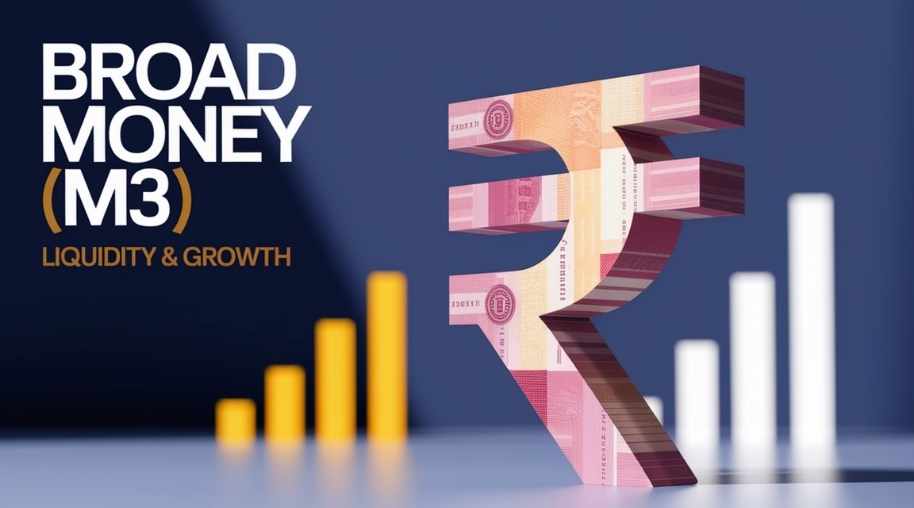M3 Full Form-Broad Money
by Shashi Gaherwar
0 1781
Broad Money: Definition, Components, Importance, and Impact on the Economy
Introduction
Broad money is a key measure of the total money supply within an economy, including cash, bank deposits, and liquid financial assets. It plays a crucial role in monetary policy, inflation control, and economic stability. Broad money is often referred to as M3 money supply, which encompasses not just physical cash but also time deposits, savings accounts, and money market instruments.

This article explores the concept, components, significance, and impact of broad money on economic growth and financial stability.
What is Broad Money?
Broad money refers to the total amount of money circulating within an economy, including highly liquid assets and those that take some time to convert into cash. It is a broader measure than narrow money (M1), which only includes physical cash and demand deposits.
Components of Broad Money
Broad money is classified into different monetary aggregates, typically categorized as M2 and M3:
- M1 (Narrow Money): Includes cash in circulation and demand deposits (checking accounts) held by the public.
- M2 (Intermediate Money): M1 plus savings deposits, fixed deposits (up to a certain period), and retail money market funds.
- M3 (Broad Money): M2 plus large time deposits, institutional money market funds, and other near-money assets.
- M4 (Extended Broad Money): M3 plus non-bank financial assets and other liquid investments.
Broad Money vs. Narrow Money
- Liquidity: Narrow money (M1) is highly liquid, while broad money (M3) is less liquid.
- Components: Narrow money includes cash and demand deposits, while broad money includes M1 plus savings and time deposits.
- Usage: Narrow money is used for daily transactions, while broad money impacts long-term financial stability.
Importance of Broad Money
- Monetary Policy Implementation: Central banks use broad money as an indicator to adjust interest rates and inflation targets.
- Economic Growth Indicator: A growing M3 suggests increased economic activity, while a decline may indicate a slowdown.
- Inflation Control: Excessive broad money supply can lead to inflation, requiring monetary tightening by the central bank.
- Liquidity Management: Helps in assessing the availability of funds for business investments and consumer spending.
- Financial Stability: Broad money growth signals the health of the banking sector and credit markets.
Factors Influencing Broad Money Supply
- Central Bank Policies: Interest rates, reserve requirements, and open market operations affect money supply.
- Bank Lending Practices: Credit availability influences how much money circulates in the economy.
- Government Spending: Increased public expenditure injects more money into the system.
- Foreign Exchange Reserves: Higher forex reserves can expand broad money supply.
- Consumer & Business Confidence: Higher savings and investments impact money circulation.
Impact of Broad Money on the Economy
- Economic Growth: Increased money supply encourages investment, job creation, and GDP expansion.
- Inflationary Pressure: Excess liquidity can lead to higher prices and reduced purchasing power.
- Interest Rate Adjustments: A rising M3 may prompt central banks to increase interest rates to control inflation.
- Exchange Rate Movements: High money supply can weaken the local currency against foreign currencies.
- Stock Market Performance: Increased liquidity often fuels investment in equities and financial markets.
Challenges in Managing Broad Money
- Risk of Inflation: Uncontrolled expansion of M3 can lead to hyperinflation.
- Debt Dependency: Excessive money supply fueled by credit growth can result in financial crises.
- Economic Slowdowns: A shrinking M3 may indicate low consumer demand and investment activity.
- Central Bank Dilemmas: Balancing money supply without triggering inflation or recession is complex.
Broad Money and Monetary Policy
- Expansionary Policy: Increasing broad money supply stimulates growth during economic slowdowns.
- Contractionary Policy: Reducing M3 curtails inflation and stabilizes the economy.
- Liquidity Regulation: Adjusting reserve requirements and interest rates controls broad money supply.
- Quantitative Easing (QE): Central banks inject liquidity to support economic activity during downturns.
Global Trends in Broad Money Growth
- Developed Economies: Stable M3 growth with strong financial regulations.
- Emerging Markets: Rapid expansion in broad money due to higher credit demand.
- Post-Crisis Adjustments: After financial crises, central banks regulate M3 to prevent excessive credit expansion.
- Digital Currency Impact: Cryptocurrencies and central bank digital currencies (CBDCs) may reshape broad money dynamics.
Conclusion
Broad money (M3) is a crucial economic indicator that reflects liquidity, financial stability, and growth potential. It influences monetary policy, inflation control, interest rates, and exchange rates.
Central banks, policymakers, and businesses closely monitor broad money supply to make informed decisions regarding investment, credit policies, and financial stability. Understanding its role helps in assessing economic health and future growth trends.
Further Learning Resources
If you’re passionate about building a successful blogging website, check out this helpful guide at Coding Tag – How to Start a Successful Blog. It offers practical steps and expert tips to kickstart your blogging journey!
For dedicated UPSC exam preparation, we highly recommend visiting www.iasmania.com. It offers well-structured resources, current affairs, and subject-wise notes tailored specifically for aspirants. Start your journey today!

Share:








Comments
Waiting for your comments